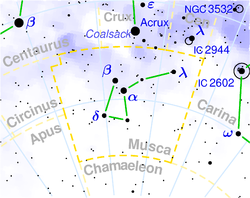- Delta Muscae
-
Delta Muscae Observation data
Epoch J2000.0 Equinox J2000.0Constellation Musca Right ascension 13h 02m 15.78s Declination -71° 32′ 55.7″ Apparent magnitude (V) +3.61 Characteristics Spectral type K2III U−B color index 1.26 B−V color index 1.18 R−I color index 0.59 Astrometry Radial velocity (Rv) 36.5 km/s Proper motion (μ) RA: 263.57 mas/yr
Dec.: −23.27 mas/yrParallax (π) 35.91 ± 0.73 mas Distance 91 ± 2 ly
(27.8 ± 0.6 pc)Absolute magnitude (MV) +1.39 Other designations Database references SIMBAD data Delta Muscae (δ Mus, δ Muscae), often catalogued as HD 112985, is a spectroscopic binary star system and the closest to the Earth in the southern hemisphere constellation of Musca (the Fly) at a distance of approximately 27.8 parsecs (91.0 light years). The main star is classified as a giant star with an orange tint. It is one of the stars given a Bayer designation by astronomer Johann Bayer. It was recorded in Bayer's 1603 publication Uranometria. In addition it is one of the main stars used in the visual formation of the Musca constellation.
Contents
Distance and visibility
Based on research done by the European Space Agency for the Hipparcos Star Catalogue, Delta Muscae exhibits a parallax of 35.91 milliarcseconds.[1] With this data, it can be calculated that Delta Muscae is situated at a distance of 27.8 parsecs, or 91.0 light years, from the sun.
Even though Delta Muscae is the closest star to Earth in the Musca constellation, nearly 3800 stars are closer in proximity to the Earth as stated by the Gliese Catalogue of Nearby Stars, which includes stars within twenty-five parsecs of the Sun.[2]
Delta Muscae is a star of the third magnitude (or 3.61(v) to be exact) when viewed from the Earth, and is visible to the naked eye in regions that lack dense light pollution.[1]
Stellar and system characteristics
Delta Muscae has a listed spectral type of K2III.[3] The K2 portion of this designation specifies that Delta Muscae A is a class K2 star, meaning the light it emits is orange in color. The main star burns at a temperature cooler than our own sun (Sol), which is a G2 star. K2 stars are on the smaller end of the Harvard spectral classification list, solely being larger than Class-M dwarves. The second part of the classification, III, specifies that Delta Muscae is a giant star which has yet to reach the main sequence of star life like our sun.
These spectral designations are for the main star in the Delta Muscae system. The system itself has been identified as a spectroscopic binary star system;[3] this means that Delta Muscae was identified as a binary system by analyzing the Doppler Effect from the emitted light of the star. There is no available data concerning Delta Muscae A's companion.[citation needed]
See also
References
- ^ a b "HIP 63613". The Hipparcos and Tycho Catalogues. ESA. 1997. http://webviz.u-strasbg.fr/viz-bin/VizieR-S?HIP%2063613. Retrieved 16 December 2008.
- ^ "Gliese Catalogue of Nearby Stars". Preliminary Version of the Third Catalogue of Nearby Stars. Gliese et all. 1991. http://webviz.u-strasbg.fr/viz-bin/VizieR-3?-to=2&-meta=1u&-source=V%2F70A%2Fcatalog. Retrieved 16 December 2008.
- ^ a b "SIMBAD Database query results". SIMBAD Database. Centre de Données astronomiques de Strasbourg. http://simbad.u-strasbg.fr/simbad/sim-basic?Ident=del+Mus. Retrieved 16 December 2008.
External links
Stars Bayer α • β • γ • δ • ε • ζ¹ • ζ² • η • θ • ι¹ • ι² • λ • μNearby Other HD 111232 (b)Other objects Categories:- Bayer objects
- Musca constellation
Wikimedia Foundation. 2010.

